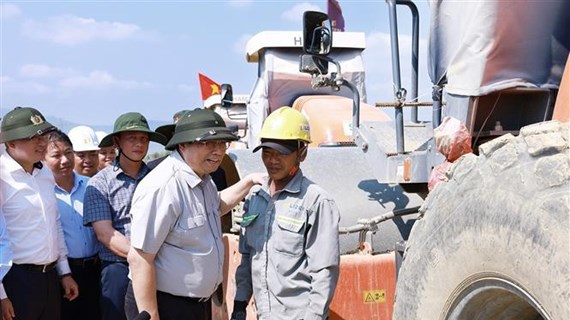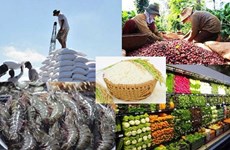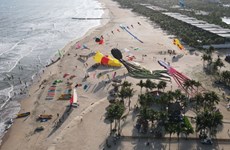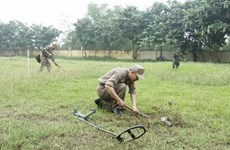Vietnam needs 20-30 billion USD investment for universal clean water access
Vietnam will need to invest 20-30 billion USD on water supply and drainage to make sure that 100% of the population has access to clean water, according to experts.
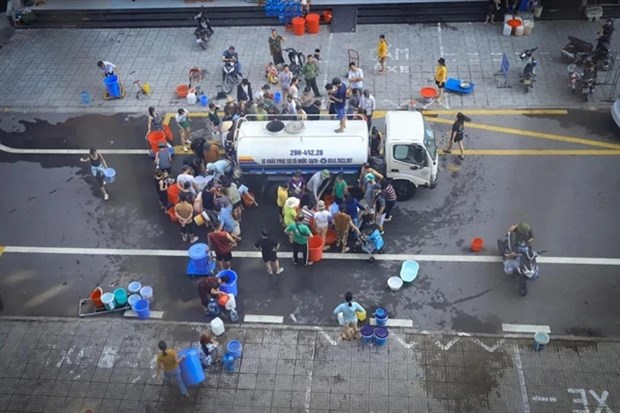 Residents at Thanh Ha Urban Area in Hanoi line up to get clean water in October 2023 due to shortage of water. (Photo: VNA)
Residents at Thanh Ha Urban Area in Hanoi line up to get clean water in October 2023 due to shortage of water. (Photo: VNA)The Ministry of Natural Resources and Environment forecasts that water use demand by 2030 is about 122.47 billion cubic metre per year.
Urban development, discharge of untreated industrial wastewater, and use of fertilisers and pesticides in agriculture, are putting great pressure on river basins, affecting clean water sources. This is particularly the case for large cities where clean water sources are a concern.
Chairman of the Vietnam Water Supply and Sewerage Association Nguyen Ngoc Diep said Vietnam is a water-abundant country but it still confronts many issues as a result of climate change, including saltwater intrusion, floods and drought.
Water use in agricultural production, along with thousands of irrigation and hydroelectric dams that ensure water source security pose deterioration and potential safety risks.
The online system for monitoring water consumption and exploitation will be maintained and operated by the Ministry of Natural Resources and Environment for approximately 600 projects by 2024. Additionally, it has encouraged the creation and use of digital maps for drought warning and forecasting.
Public health has been impacted by water contamination, and socioeconomic growth has decreased. As this is happening, the majority of wastewater in Vietnam is not treated before release into the environment.
Urban flooding has also grown to be a major issue, particularly in major cities like Hanoi, Ho Chi Minh City, Da Nang, Vinh and Da Lat.
Several streets in Hanoi and HCM City have remained submerged after heavy rains in recent years. The National Centre for Hydrometeorological Forecasting consistently issues warnings about floods in metropolitan areas.
According to Diep, there are 750 clean water treatment facilities in Vietnam as of right now, with a combined capacity of over 1 million cubic meters each day and night.
Up to 92% of people living in cities have access to clean water.
The country has nearly 410 industrial parks using and treating wastewater with a capacity of 400,000cu.m per day and night.
There are 71 drainage and wastewater treatment enterprises operating 82 wastewater treatment plants.
Despite having a design capacity of one million cubic metres per day, the plants have only been used to a capacity of roughly 700,000cu.m per day.
The real wastewater collection rate is only about 60%, and the treatment rate is only 17% of the approximately 80 operational wastewater treatment projects, each having a capacity of more than two million cubic meters per day and night.
Professor Nguyen Viet Anh, Director of the Institute of Environmental Science and Engineering (University of Civil Engineering) said Vietnam’s water industry has faced too rapid urban development. Infrastructure cannot keep up with growth, and essential water services fail to meet requirements.
He cited the Mekong Delta region as an example, where several provinces have had to establish water delivery systems upstream, kilometres away from the province boundary, as another challenge brought about by climate change.
“A lot of localities have to bring water from other places to supply agricultural production and domestic water. This shows that the challenge of climate change is increasingly fierce and present," he told VietnamPlus.vn, saying that it is necessary to find new solutions to droughts and saltwater intrusion.
He said Vietnam still relies on ODA capital. The water sector is not attractive for private sector investment due to low profits, although it benefits society.
Diep, Chairman of the Vietnam Water Supply and Sewerage Association, said in order for 100% of people to have clean water, Vietnam will have to make a large investment of about 9 billion USD by 2030, a "very challenging" issue for Vietnam when investment resources are still limited.
Anh said with current water resource challenges, in the next 10 years, Vietnam's water industry will need to raise about 20-30 billion USD to meet all water supply and drainage requirements, including clean water supply projects, and domestic and industrial wastewater treatment.
In order to develop a suitable policy framework, he advised managers to do a thorough assessment of the value of water.
He stated that funding must be raised in order to invest in this field's infrastructure.
Halla Maher Qaddumi, a senior water economist at the World Bank, said Vietnam might lose 6% of its GDP every year until 2035. Water pollution alone may cause a drop of 3.5% of GDP.
To resolve issues in the water sector, the World Bank said attracting investments from the private sector should be done to replace old infrastructure. To attract investments, the government needs to have strong financial policies and legal frameworks, Halla said./.





